Malaysia
Malaysia is a
federalconstitutional monarchy in Southeast Asia. It consists of
thirteen states and three federal territories and has a total landmass
of 329,845 square kilometres (127,354 sq mi). The country is separated
by the South China Sea into two regions, Peninsular Malaysia and
Malaysian Borneo (also known as West and East Malaysia respectively).
Malaysia shares land borders with Thailand, Indonesia, and Brunei and
has maritime boundaries with Singapore, Vietnam, and the Philippines.
The capital city is Kuala Lumpur, while Putrajaya is the seat of the
federal government. The population as of 2009 stood at over 28 million.
Malaysia has its
origins in the Malay Kingdoms present in the area which, from the 18th
century, became subject to the British Empire. The first British
territories were known as the Straits Settlements. Peninsular Malaysia,
then known as Malaya, was first unified under the commonwealth in 1946,
before becoming the Federation of Malaya in 1948. In 1963,
Malayaunified with Sabah,
Sarawak, and Singapore. In 1965, Singapore opted out of the federation
and became an independent city state. Since its independence, Malaysia
has had one of the best economic records in Asia, with GDP growing an
average 6.5% for the first 50 years of independence.[9] The economy of
the country has, traditionally, been fuelled by its natural resources,
but is now also expanding in the sectors of science, tourism, commerce
and medical tourism.
Malaysia's head of
state is the Yang di-Pertuan Agong, conventionally referred to as "the
Head" or "the Agong". The Agong is an elected monarch chosen from one
of the sultans from the 9 Malay states. The head of government is the
Prime Minister.[10][11] The government system is closely modelled on
the Westminster parliamentary system [12] and the legal system is based
on English Common Law.
Malaysia, which, in
Tanjung Piai, can claim the southernmost point of continental Eurasia,
is located near the equator and has a tropical climate.[2] It has a
biodiverse range of flora and fauna, and is considered one of the 17
megadiverse countries.[13] It is a founding member of theAssociation of
Southeast Asian Nations and the Organisation of the Islamic Conference,
and a member of Asia-Pacific Economic Cooperation, the Commonwealth of
Nations, and the Non-Aligned Movement.
|
Malaysia
|

 |
| Flag |
|
Motto: "Bersekutu
Bertambah Mutu"
"Unity Is Strength" [1] |
Anthem: Negaraku (My Country)
|
|
Malaysia in
ASEAN
|
| Capital |
Kuala Lumpur[a]
Putrajaya (administrative centre)
 3°08′N 101°42′E / 3.133°N
101.7°E / 3.133;
101.7 3°08′N 101°42′E / 3.133°N
101.7°E / 3.133;
101.7 |
| Largest city |
Kuala Lumpur |
| Official
language(s) |
Bahasa Malaysia[b] |
| Ethnic groups |
50.4% Malay
23.7% Chinese
7.1% Indian
11.0% Indigenous
7.8% Other [2] |
| Demonym |
Malaysian |
| Government |
Federal constitutional elective monarchy
and parliamentary democracy |
| - |
Yang di-Pertuan
Agong |
Mizan Zainal Abidin |
| - |
Prime Minister |
Najib Tun Razak |
| - |
Deputy Prime
Minister |
Muhyiddin Yassin |
| Independence |
| - |
From the United
Kingdom (Malaya only) |
31 August 1957 |
| - |
Federation (with
Sabah,
Sarawak and Singapore[c] |
16 September 1963 |
| Area |
| - |
Total |
329,845 km2 (66th)
127,354 sq mi |
| - |
Water (%) |
0.3 |
| Population |
| - |
2009 estimate |
28,310,000[3] (43rd) |
| - |
2000 census |
24,821,286 |
| - |
Density |
85.8/km2 (114th)
222.3/sq mi |
| GDP (PPP) |
2010 estimate |
| - |
Total |
$403.042 billion[4] |
| - |
Per capita |
$14,275.371[4] |
| GDP (nominal) |
2010 estimate |
| - |
Total |
$213.065 billion[4] |
| - |
Per capita |
$7,546.559[4] |
| Gini (2004) |
40.3 |
| HDI (2007) |
▲ 0.829[5] (high) (66th) |
| Currency |
Ringgit (RM) (MYR) |
| Time zone |
MST (UTC+8) |
| - |
Summer (DST) |
Not observed (UTC+8) |
| Date formats |
dd-mm-yyyy |
| Drives on the |
Left |
| Internet TLD |
.my |
| Calling code |
+60 |
|
^ a.
Kuala Lumpur is the capital city and is home to the legislative branch
of the Federal government. Putrajaya is the primary seat of the federal
government where the executive and judicial branches are located.
|
Etymology
The name
Malaysia was adopted in 1963 when the existing states of the Federation
of Malaya, plus Singapore, North Borneo and Sarawak formed a new
federation.[14] Prior to that, the name itself had been vaguely used to
refer to areas in Southeast Asia. A map published in 1914 in Chicago
has the word Malaysia printed on it referring to certain territories
within the Malay Archipelago.[15] The continental part of the country
bore the name Federation of Malaya until 1963, when it federated with
the territories of Sabah,Sarawak,
and Singapore.[16][17] Politicians in thePhilippines once contemplated
naming their state "Malaysia", but in 1963 Malaysia adopted the name
first.[18] At the time of the 1963 federation, other names were
considered: among them wasLangkasuka, after the historic kingdom
located at the upper section of the Malay Peninsula in the first
millennium of the common era.
The word
Melayu derives from the Sanskrit term Malaiur or Malayadvipa which can
be translated as "land of mountains", the word used by ancient Indian
traders when referring to the Malay Peninsula.[20][21][22][23][24] The
term was later used in reference to the Melayu Kingdom,[25] that
existed between the 7th and the 13th on Sumatra.
In 1850 the
English ethnologist George Samuel Windsor Earl, writing in the Journal
of the Indian Archipelago and Eastern Asia, proposed naming the islands
of Indonesia as Melayunesia or Indunesia. He favoured the former[26]
for the colonial reference. Following his 1826 expedition in Oceania,
the French Navigator Jules Dumont d'Urville invented the terms
Malaisia, Micronesia andMelanesia, distinguishing these Pacific
cultures and island groups from Polynesia. In 1831, he proposed these
terms to The Société de Géographie. For the name Malaisia, Dumont
d'Urville had in mind a region including present day Indonesia,
Malaysia and the Philippines. At that time, it was thought that the
inhabitants of this region could be designated by the encompassing term
"Malay" in line with that era's concept of aMalay race, which contrasts
with contemporary definitions by which "Malay" refers to an ethnic
group of similar culture who speak the Malay language and live on the
east coast of Sumatra, the Riau Islands, the Malay Peninsula and the
coastline of the island of Borneo. The related term "Malay world" is
used to refer to this extended geographical area.
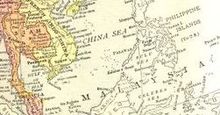
Malaysia used to represent the Malay
archipelago on a 1914 map from a United States atlas.
History
Evidence of
human habitation in Malaysia dates back 40,000 years. The Malay
Peninsula was known to ancient Indians as Suvarnadvipa or the "Golden
Peninsula", and was shown on Ptolemy's map as the "Golden Khersonese".
Traders and settlers from India and China arrived as early as the first
century of the common era, establishing trading ports and towns in the
area in the 2nd and 3rd centuries CE. Both had a strong influence on
the local culture. In the early centuries of the first millennium, the
people of the Malay Peninsula adopted the Indian religions of Hinduism
and Buddhism, as well as the use of the Sanskrit writing system.
Between the 7th and the 13th century, much of Peninsular Malaysia was
under the Srivijaya empire, which was centered in Palembang on the
island of Sumatra. After the fall of Srivijaya, the Java-based
Majapahit empire had influence over most of Indonesia, Peninsular
Malaysia, and the coasts of Borneo island. In the early 15th century,
Parameswara, a prince of the former Srivijayan empire, established a
dynasty and founded what would become the Malacca Sultanate, commonly
considered the first independent state in the peninsula. Parameswara
became a Muslim, and Malacca's prominent position and economic power
allowed this faith to spread to neighbouring states, leading is to
become the dominant religion among Malays by the 16th century.
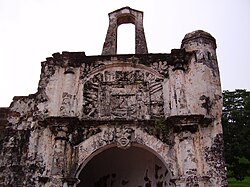
A Famosa fortress in Malacca. It was built
by the Portuguese in the 16th century.
The first
colonial claim occurred in 1511, when Malacca was conquered by
Portugal, who established a colony there. The British Empire set foot
on the Malay Peninsula in 1786, with the lease of the island of Penang
to the British East India Company by the sultan of Kedah.[32] Singapore
was occupied slightly after this[33]. In 1824, the British took control
of Malacca following the Anglo-Dutch Treaty of 1824 which divided the
Malay archipelago between Britain and the Netherlands, with Malaya in
the British zone. By 1826 the British controlled Penang, Malacca,
Singapore and the island of Labuan, which they established as the crown
colony of the Straits Settlements. By the turn of the 20th century, the
states of Pahang, Selangor, Perak, and Negeri Sembilan, known together
as the Federated Malay States, had British Residents appointed to
advise the Malay rulers, whom the rulers were bound by treaty to defer
to.[34] The remaining five states in the peninsula, known as the
Unfederated Malay States, while not directly under rule from London,
also accepted British advisers around the turn of the 20th century. Sabah was governed as the
crown colony of British North Borneo. Sarawak was given to James Brooke
by the Sultan of Brunei, who ruled as the white Rajahs in an
independent Sultanate until 1946, when it was handed over to the
British.
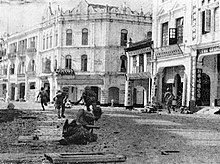
Japanese
troops in Kuala Lumpur
After WWII,
following the Japanese invasion and subsequent occupation of Malaya,
popular support for independence grew.[36] Post-war British plans to
unite the administration of Malaya under a single crown colony called
the Malayan Union foundered on strong opposition from the Malays, who
opposed the emasculation of the Malay rulers and the granting of
citizenship to the ethnic Chinese.[37] The Malayan Union, established
in 1946 and consisting of all the British possessions in the Malay
peninsula with the exception of Singapore, was dissolved in 1948 and
replaced by theFederation of Malaya, which restored the autonomy of the
rulers of the Malay states under British protection. During this time,
rebels under the leadership of the Malayan Communist Party launched
guerrilla operations designed to force the British out of Malaya. The
Malayan Emergency, as it was known, lasted from 1948 to 1960, and
involved a long anti-insurgency campaign by Commonwealthtroops in
Malaya. In 1963, Malaya along with the then British crown colonies of Sabah, Sarawak and
Singapore, federated to form Malaysia. The proposed date for the
formation of Malaysia was 31 August 1963, to coincide with the
independence day of Malaya and the British giving self-rule to Sarawak
and Sabah. However,
the date was delayed until September 16, 1963, due to opposition from
the Indonesian government led by Sukarno and attempts by the Sarawak
United People's Party to delay the formation of Malaysia.
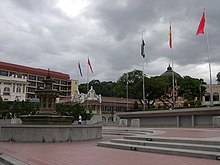
Dataran Merdeka (Independence Square) in
Kuala Lumpur, where Malaysians celebrate Independence Day on 31 August
each year
Independence,
in its initial period, brought heightened tensions in the form of
conflict with Indonesia(Konfrontasi) over the formation of Malaysia,
Singapore's eventual exit in 1965,[38] and racial strife in the form of
race riots in 1969.[39][40] After the 13 May race riots of 1969, the
controversial New Economic Policy—intended to increase proportionally
the share of the economic "pie" of thebumiputras ("indigenous people",
which includes the majority Malays, but not always the indigenous
population) as compared to other ethnic groups—was launched by Prime
Minister Tun Abdul Razak. Malaysia has since maintained a delicate
ethno-political balance, with a system of government that has attempted
to combine overall economic development with political and economic
policies that promote equitable participation of all races.
Under the
premiership of Mahathir bin Mohamad, Malaysia experienced economic
growth from the 1980s, a 1985-86 property market depression,[42] and
returned to growth through to the mid-1990s.[43] The period saw a shift
from an agriculture-based economy to one based on manufacturing and
industry in areas such as computers and consumer electronics. It was
during this period, too, that the physical landscape of Malaysia
changed with the emergence of numerous mega-projects. Notable amongst
these projects were the construction of the Petronas Twin Towers (at
the time the tallest building in the world, and, as of 2010, still the
tallest twin building), KL International Airport (KLIA), the
North-South Expressway, the Sepang International Circuit, the
Multimedia Super Corridor (MSC), the Bakun hydroelectric dam and
Putrajaya, the new federal administrative capital. In the late 1990s,
Malaysia was shaken by the Asian financial crisis as well as political
unrest caused by the sacking of the deputy prime minister Dato' Seri
Anwar Ibrahim.[44]In November 2007, Malaysia was rocked by two
anti-government rallies. They were precipitated by allegations of
corruption and discrepancies in the Malaysian election system that
heavily favoured the ruling political party, Barisan Nasional, which
had been in power since Malaysia achieved its independence in 1957.
Foreign relations and military
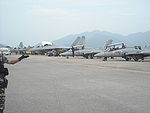
The RMAF state-of-art Sukhoi Su-30 MKM
MRCA.
Malaysia's
foreign policy is based on the principle of neutrality and maintaining
peaceful relations with all countries, regardless of their political
system, and to further develop relations with other countries in the
region.[61] It attaches a high priority to the security and stability
of Southeast Asia, and has tried to strengthen relations with other
islamic states.
Malaysia is a
founding member of the Association of Southeast Asian Nations (ASEAN)
and the Organisation of the Islamic Conference.[63][64] The country
participates in many international organisations such as the United
Nations, the Asia-Pacific Economic Cooperation, the Developing 8
Countries and the Non-Aligned Movement.[65][66][67][68] As a former
British colony, it is also a member of the Commonwealth of Nations.[69]
Kuala Lumpur was the site of the first East Asia Summit in 2005.[62]
Malaysia has no diplomatic relations with the State of Israel.
The policy
towards territorial disputes by the Malaysian government is one of
pragmatism, solving disputes in a number of ways, including some
resolved in the International Court of Justice.[71] The Spratly Islands
are disputed by many states in the area, although tensions have eased
since the 2002 "Declaration on the Conduct of Parties in the South
China Sea". Brunei and Malaysia in 2008 announced an end to land
claims, and to resolve issues related to their maritime borders. The
Philippines has a dormant claim on Sabah. Singapore's land
reclamation has caused tensions between the two countries, and maritime
border disputes exist with Indonesia.
Malaysian
defence requirements are assigned to the Malaysian Armed Forces
(Angkatan Tentera Malaysia - ATM). The armed forces has three branches,
the Royal Malaysian Navy (Tentera Laut Diraja Malaysia - TLDM),
Malaysian Army (Tentera Darat Malaysia - TD), and the Royal Malaysian
Air Force (Tentera Udara Diraja Malaysia - TUDM). Malaysia does not
have conscription, and the required age for voluntary military service
is 18. 1.9% of Malaysia's GDP is spent on the military, which hires
1.23% of Malaysia's manpower.
The Five
Power Defence Arrangement between Malaysia, Singapore, Australia, New
Zealand, and the United Kingdom, is a regional security initiative
which has been in place for almost 40 years. It involves joint military
exercises held between the 5 countries.[74] Joint exercises and war
games have been held with Indonesia for years.[75] Malaysia and the
Philippines have agreed to host joint exercises between their security
forces, in order to secure their maritime border and tackle issues such
as illegal immigration.[76] There are fears that unrest in the Muslim
areas of the southern Philippines[77] and southern Thailand[78] could
spill over into Malaysia.
Geography
Malaysia is
the 43rd most populated country and the 66th largest country by total
land area in the world, with a population of about 28 million and a
land area of over 320,000 km2 respectively. On land, Malaysia borders
Thailand, Indonesia, and Brunei[2] and it has maritime boundaries with
its neighbours Singapore, Vietnam[84], and the Philippines[85]. The
land borders are now well established and defined in large part by
geological features such as the Perlis River, Golok River and the
Pagalayan Canal, whilst some of the maritime boundaries have been the
subject of ongoing contention. Tanjung Piai, located in the southern
state of Johor, is the southernmost tip of continental Asia.[86][87]
The Strait of Malacca, lying between Sumatra and Peninsular Malaysia,
is arguably the most important shipping lane in the world.
The two
distinct parts of Malaysia, separated from each other by the South
China Sea, share a largely similar landscape in that both West and East
Malaysia feature coastal plains rising to often densely forested hills
and mountains.[89] East Malaysia, like most of the island of Borneo,
was traditionally covered with Borneo lowland rain forests although
much has been cleared causing wildlife to retreat into the upland rain
forests inland. Malaysia's rainforest's are made of a variety of types,
although they are mainly dipterocarp forests. These forests contain the
Rafflesia, the largest flower in the world.[90] Malaysia is a
megadiverse country, with a high number of species and high levels of
endemism.[13] Although the forests are in decline, some state
governments have taken measures to halt this.
Peninsula
Malaysia is divided between its east and west coasts by the Titiwangsa
Mountains.[91] These mountains are heavily forested, and mainly
composed of granite. The range is the origin of some of Peninsula
Malaysia's river systems.[92] The state of Sabah is similarly
divided by the Crocker Range,[93] which is the location of Mount
Kinabalu. Mount Kinabalu, at 4,095.2 metres (13,436 ft), is the tallest
mountain in Malaysia and is protected as Kinabalu National Park, a
UNESCO World Heritage Site.[94] Malaysia contains numerous islands, and
its waters extend into the Coral Triangle.[95] The local climate is
equatorial and characterised by the annual southwest (April to October)
and northeast (October to February) monsoons.
Kuala Lumpur
is the official capital[96] and largest city of Malaysia.[97] Putrajaya
is the federal administrative capital.[98] Although many executive and
judicial branches of the federal government have moved there (to ease
growing congestion within Kuala Lumpur), Kuala Lumpur is still
recognised as the legislative capital of Malaysia since it houses the
seat of the Parliament of Malaysia. It is also the main commercial and
financial centre of the country.

Kota Kinabalu,
capital of East Malaysian state of Sabah is located 1,600
kilometres (990 mi) east across the South China Sea from Kuala Lumpur.
Demographics
Malaysia's
population comprises many ethnic groups, with the Malays making up the
majority at 50.4%; and other bumiputra at 11%[128] of the population.
According to constitutional definition, Malays are Muslims who practice
Malay customs (adat) and culture. Therefore, technically, a Muslim of
any race who practices Malay customs and culture can be considered a
Malay and allocated privilleged status in the form of the rights
stipulated in the constitution for Malays, aboriginals and natives
(commonly referred to as Bumiputra, although the constitution itself
does not use this term).[129][130] Bumiputra status is also accorded to
certain non-Malay indigenous peoples, including ethnic Thais, Khmers,
Chams and the natives of Sabah
and Sarawak. Non-Malay bumiputra make up more than half of Sarawak's
population (of which 30% are Ibans), and close to 60% of Sabah's
population (of which 18% are Kadazan-Dusuns, and 17% are Bajaus).[128]
There also exist aboriginal groups in much smaller numbers on the
peninsula, where they are collectively known as Orang Asli.
Various other
minorities who lack Bumiputra status have established themselves in
Malaysia, for a variety of reasons. 23.7% of the population are
Malaysians of Chinese descent, while Malaysians of Indian descent
comprise 7.1% of the population.[128] Indians began migrating to
Malaysia in the early 19th century.[131] The majority of the Indian
community are Tamils. Many Europeans and Middle Easterners assimilated
through inter-marriage into the Christian and Muslim communities
respectively. Most Eurasian Malaysians trace their ancestry to British,
Dutch or Portuguese colonists.
Malaysian
citizenship is usually granted by lex soli.[132] Citizenship in the
states of Sabah and
Sarawak in Malaysian Borneo are distinct from citizenship in Peninsular
Malaysia for immigration purposes. Every citizen is issued a biometric
smart chip identity card, known as MyKad, at the age of 12, and must
carry the card at all times.[133]
The
population distribution is highly uneven, with some 20 million
residents concentrated on the Malay Peninsula, while East Malaysia has
about 7 million people. Due to the rise in labour intensive industries,
Malaysia has 10% to 20% foreign workers, the exact figure being
uncertain due in part to the large number of illegal workers. There are
a million legal foreign workers and perhaps another million
unauthorised foreigners. The state of Sabah alone had nearly
25% of its 2.7 million population listed as illegal foreign workers in
the last census. Sabah
NGOs estimate that out of the 3 million population, 2 million are
illegal immigrants.
Additionally,
according to the World Refugee Survey 2008, published by the U.S.
Committee for Refugees and Immigrants, Malaysia hosts a population of
refugees and asylum seekers numbering approximately 155,700. Of this
population, approximately 70,500 refugees and asylum seekers are from
the Philippines, 69,700 from Burma, and 21,800 from Indonesia.[135] The
U.S. Committee for Refugees and Immigrants named Malaysia as one of the
Ten Worst Places for Refugees on account of the country's
discriminatory practices toward refugees. Malaysian officials are
reported to have turned deportees directly over to human smugglers in
2007, and Malaysia employs RELA, a volunteer militia, to enforce its
immigration law.
Largest Cities
of Malaysia
City
State
Population
Kuala
Lumpur
Federal
Territory
1,809,699
Subang
Jaya
Selangor
1,321,672
Klang
Selangor
1,055,207
Johor
Bahru
Johor
895 509
Ampang
Jaya
Selangor
756,309
Ipoh
Perak
710,798
Kuching
Sarawak
658,562
Shah
Alam
Selangor
617,149
Kota Kinabalu
Sabah
579,304
Kota
Bharu
Kelantan
577,301
Petaling
Jaya
Selangor
543,415
Tebrau
Johor
525,351
Cheras,
Selangor
Selangor
515,961
Sandakan
Sabah
479,121
Religion

Kampung Laut Mosque in Tumpat is one of
the oldest mosques in Malaysia, dating to early 18th century
The Malaysian
constitution guarantees religious freedom, although Islam is the
largest and official religion of Malaysia. According to the Population
and Housing Census 2000 figures, approximately 60.4% of the population
practiced Islam; 19.2% Buddhism; 9.1% Christianity; 6.3% Hinduism; and
2.6% practice Confucianism, Taoism and other traditional Chinese
religions. The remainder was accounted for by other faiths, including
animism, folk religion, and Sikhism while 0.9% either reported having
no religion or did not provide any information.
All ethnic
Malays are considered Muslim by Article 160 of the Constitution of
Malaysia.[138] Statistics from the 2000 Census indicate that 75.9% of
Malaysian Chinese identify as Buddhist, with significant numbers of
adherents following Taoism (10.6%) and Christianity (9.6%), along with
small Hui-Muslim populations in areas like Penang.[137] The majority of
Malaysian Indians follow Hinduism (84.5%), with a significant minority
identifying as Christians (7.7%), Muslims (3.8%), over 150,000 Sikhs,
and 1,000 Jains. Christianity is the predominant religion of the
non-Malay Bumiputra community (50.1%) with an additional 36.3%
identifying as Muslims and 7.3% follow folk religion.
Muslims are
obliged to follow the decisions of Syariah courts in matters concerning
their religion. The Islamic judges are expected to follow the Shafi`i
legal school of Islam, which is the main madh'hab of Malaysia.[139] The
jurisdiction of Shariah courts is limited only to Muslims in matters
such as marriage, inheritance, divorce, apostasy, religious conversion,
and custody among others. No other criminal or civil offences are under
the jurisdiction of the Shariah courts, which have a similar hierarchy
to the Civil Courts. Despite being the supreme courts of the land, the
Civil Courts (including the Federal Court) do not hear matters related
to Islamic practices.
Language
The official
language of Malaysia is known as Bahasa Malaysia, a standardized form
of the Malay language. English was, for a protracted period, the de
facto, administrative language of Malaysia, though its status was later
rescinded. English remains an active second language in many areas of
Malaysian society and is compulsory, serving as the medium of
instruction for Maths and Sciences in all public schools.[141][142]
Malaysian English, also known as Malaysian Standard English (MySE), is
a form of English derived from British English, although there is
little official use of the term, except with relation to education.
Malaysian English also sees wide use in business, along with Manglish,
which is a colloquial form of English with heavy Malay, Chinese dialect
and Tamil influences. Most Malaysians are conversant in English,
although some are only fluent in the Manglish form. The Malaysian
government officially discourages the use of Manglish.
Tamil is the
most common language spoken among Indians in Malaysia.[144] Chinese
Malaysians mostly speak Chinese dialects from the southern provinces of
China. The more common dialects in Peninsular Malaysia are Hakka,
Hokkien, Cantonese, Teochew, Hainanese, and Hokchiu.
The native tribes of East Malaysia have their own languages which are
related to, but easily distinguishable from, Malay. The Iban is the
main tribal language in Sarawak while Dusunic languages are spoken by
the natives in Sabah.[146]
A variant of the Malay language[specify] that is spoken in Brunei is
also commonly spoken in both states.
Education

Malay College Kuala Kangsar (MCKK) is one
of the earliest boarding schools established in British Malaya.
Education in
Malaysia is monitored by the federal government Ministry of
Education.[147] The education system of Malaysia features a
non-compulsive kindergarten education, followed by six years of
compulsory primary education[9] and five years of secondary education.
Schools in
the primary education system is divided into two categories, the
national primary school and the vernacular school.[148] The vernacular
schools use either Chinese or Tamil as the medium of instruction,
whereas national primary schools (Sekolah Kebangsaan) use Bahasa
Malaysia as the medium of instruction for all subjects except English,
Science and Mathematics. Before progressing to the secondary level of
education, pupils in Year 6 are required to sit for the Primary School
Achievement Test (Ujian Pencapaian Sekolah Rendah, UPSR).
Secondary
education in Malaysia is conducted in secondary schools (Sekolah
Menengah Kebangsaan) for five years. National secondary schools use
Bahasa Malaysia as the main language of instruction. The only
exceptions are Mathematics and Science and languages other than Bahasa
Malaysia. At the end of Form Three, which is the third year, students
are evaluated in the Lower Secondary Assessment (Penilaian Menengah
Rendah, PMR). In the final year of secondary education (Form Five),
students sit the Malaysian Certificate of Education (Sijil Pelajaran
Malaysia, SPM) examination, which is equivalent to the former British
Ordinary or 'O' Levels. The government has decided to abandon the use
of English in teaching maths and science and revert to Bahasa Malaysia,
starting in 2012.
Before the
introduction of the matriculation system, students aiming to enter
public universities had to complete an additional 18 months of
secondary schooling in Form Six and sit the Malaysian Higher School
Certificate (Sijil Tinggi Persekolahan Malaysia, STPM); equivalent to
the British Advanced or 'A' levels.[150] Since the introduction of the
matriculation programme as an alternative to STPM in 1999, students who
completed the 12-month programme in matriculation colleges (kolej
matrikulasi in Malay) can enrol in local universities. However, in the
matriculation system, only 10% of the places are open to non-Bumiputra
students while the rest are reserved for Bumiputra students.
Healthcare
The Malaysian
government places importance on the expansion and development of health
care, putting 5% of the government social sector development budget
into public health care. Over the last couple of years, the Malaysian
Health Ministry has increased its efforts to overhaul the system and
attract more foreign investment.The Government has also been trying to
promote Malaysia as a health care destination, regionally and
internationally.[152] The government implements a universal healthcare
system, which co-exists with the private healthcare system.[153] Infant
mortality rate – a standard in determining the overall efficiency of
healthcare – in 2005 was 10, comparing favourably with the United
States and western Europe. Life expectancy at birth in 2008 was 74
years.[154] The Malaysian health care system requires doctors to
perform a compulsory three years service with public hospitals to
ensure that the manpower in these hospitals is maintained.
A major
problem with the health care sector is the lack of medical centres for
rural areas, which the government is trying to counter through the
development of and expansion of a system called "tele-primary
care".[153] Another issue is the overperscription of drugs, though this
has decreased in recent years.
Culture

A cook making
murtabak, a type of pancake filled with eggs, small chunks of meat and
onions, in Kuala Lumpur.
Malaysia is a multi—ethnic, multicultural and
multilingual society. The Malays form the largest community and play a
dominant role politically. Their language, Malay (Bahasa Malaysia), is
the national language of the country.[156] Citizens of Minangkabau,
Bugis or Javanese origins, who can be classified "Malay" under
constitutional definitions may also speak their respective ancestral
tongues. However, English is also widely spoken in major towns and
cities across the country. Malays are defined by the constitution as
Muslim, although Malay culture shows strong influences from Hinduism,
Buddhism and animism. Since the Islamisation movement of the 1980s and
90s, these aspects are often neglected or banned altogether. Because
any Malay-speaking Muslim is entitled to bumiputra privileges, many
non-Malay Muslims have adopted the Malay language, customs and attire
in the last few decades. This is particularly the case with Indian
Muslims from the peninsula and the Kadayan of Borneo.
Malaysia has many other non—malay indigenous people, the
largest of which is the Iban of Sarawak, who number over 600,000 and
who still live in traditional longhouses which can hold up to 200
people.[157] The Bidayuhs, numbering around 170,000, are concentrated
in the southwestern part of Sarawak. The largest indigenous tribe in Sabah is the Kadazan,
most of whom are Christians[158] and rice farmers.[159] The 140,000
Orang Asli, or aboriginal peoples, comprise a number of different
ethnic communities living in peninsular Malaysia. Many tribes, both on
the peninsula and in Borneo, were traditionally nomadic or semi-nomadic
hunter—gatherers, including the Punan, Penan and Senoi. However, their
ancestral land and hunting grounds are commonly reclaimed by the state,
shifting them to inferior land and sometimes pushing them out of their
traditional way of life.
There is a large Chinese Malaysian population who have
historically been dominant in the Malaysian business and commerce
community and have a majority in Penang. There also exists a large
mainly Tamil Indian population. They originally migrated from India as
traders, teachers or other skilled workers, sometimes forced to by the
British during colonial times to work in the plantation
industry.[161][162] A Tamil Muslim community of 200,000 also thrives as
an independent subcultural group. A small number of Malaysians have
caucasian ancestry, and speak a variety of creole languages. Other
minorities include Malaysian Siamese, Khmers, Chams, and Burmese.
|
Politics
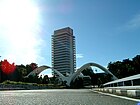
The Malaysian Houses of Parliament is the
building where the Malaysian Parliament assembles.
Malaysia is a
federal constitutional elective monarchy. The federal head of state of
Malaysia is the Yang di-Pertuan Agong, commonly referred to as the King
of Malaysia. The Yang di-Pertuan Agong is elected to a five-year term
among the nine hereditary Sultans of the Malay states; the other four
states, which have titular Governors, do not participate in the
selection.[46] The system of government in Malaysia is closely modelled
on that of the Westminster parliamentary system, a legacy of British
colonial rule.
Legislative
power is divided between federal and state legislatures. The bicameral
parliament consists of the lower house, the House of Representatives or
Dewan Rakyat (literally the "Chamber of the People") and the upper
house, the Senate or Dewan Negara (literally the "Chamber of the
Nation").[47][48][48] The 222-member House of Representatives is
elected for a maximum term of five years from single-member
constituencies, which are defined based on population. All 70 Senators
sit for three-year terms; 26 are elected by the 13 state assemblies,
with the remaining 44 appointed by the king upon the Prime minsters
recommendation.[9] The parliament follows a multi-party system and the
governing body is elected through a first-past-the-post system. Since
independence in 1957, Malaysia has been governed by a multi-party
coalition known as the Barisan Nasional (formerly known as the Alliance
Party).
Besides the
Parliament at the federal level, each state has a unicameral state
legislative chamber (Malay: Dewan Undangan Negeri) whose members are
elected from single-member constituencies. State governments are led by
Chief Ministers[9] (Menteri Besar in Malay states or Ketua Menteri in
states without hereditary rulers), who are state assembly members from
the majority party in the Dewan Undangan Negeri. In each of the states
with a hereditary ruler, the Chief Minister is required to be a
Malay-Muslim, although this rule is subject to the rulers' discretion.
Parliamentary elections are held at least once every five years, with
the last general election being in March 2008.[49] Registered voters of
age 21 and above may vote for the members of the House of
Representatives and, in most of the states, for the state legislative
chamber. Voting is not mandatory.
Executive power is vested in the cabinet led by the prime minister; the
Malaysian constitution stipulates that the prime minister must be a
member of the lower house of parliament who, in the opinion of the Yang
di-Pertuan Agong, commands a majority in parliament.[51] The cabinet is
chosen from among members of both houses of Parliament and is
responsible to that body.
The judiciary of Malaysia is independent of the executive and the
legislature.[53] The highest body in the judicial system is the Federal
Courts. Underneath these courts, there are two high courts, one for
Peninsula Malaysia and one for East Malaysia.[54] Despite Malaysia
being a federation, the court system is highly centralized.[55]
Malaysia's legal system is based upon English Common Law.
Separate from
the civil courts of Malaysia are Sharia courts, which decide on cases
which involve Malaysian Muslims.[56] The sharia courts are run parallel
to the normal court system, and are undergoing reforms that include the
first ever appointment of female judges.[57] Debate exists in Malaysia
over whether the country should be secular or islamic,[58] some states
have passed Islamic laws, but they have not gone into effect due to
opposition from the federal government.
Race plays a
large role in Malaysian politics. The Government's New Economic Policy
(NEP)[41] and the National Development Policy (NDP) which superseded
it, were implemented to advance the standing of Bumiputera Malaysians.
The policies provide preferential treatment to Malays over non-Malays
in employment, education, scholarships, business, and access to cheaper
housing and assisted savings. While improving in the economic position
of Malays, it is a source of resentment amongst non-Malays.
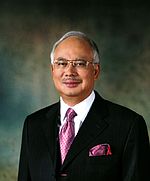
Current Prime Minister of Malaysia, Najib
Tun Razak.
Subdivisions
Malaysia is
divided into 13 states (Negeri) and 3 federal territories (Wilayah
Persekutuan). 11 states and 2 federal territories are on Peninsula
Malaysia, the other 2 states and 1 federal territory are in East
Malaysia. As Malaysia is a federation, the governance of the states is
divided between the federal and the state governments, while the
Federal government has direct administration of the federal territories.
The 13 states
are based on historical Malay Kingdoms, and each state is further
divided into districts (daerah or jajahan in Kelantan), which are then
divided into mukim. 9 of the 13 states, known as the Malay States,
retain their royal families. The Federal King (titled Yang di-Pertuan
Agong) is elected (de facto rotated) among the nine rulers to serve a
5-year term.[9] Each state has a unicameral legislature called Dewan
Undangan Negeri. The states of East Malaysia ( Sabah and Sarawak) have
separate immigration policies and controls and a unique residency
status.[80] Visas are required for travel between these two states or
between either state and peninsular Malaysia.[81] For some, the other
areas of Malaysia are considered foreign countries under immigration
laws.
The
Parliament of Malaysia is permitted to legislate on issues of land,
Islamic religion and local government in order to provide for a uniform
law between different states, or on the request of the state assembly
concerned. The law in question must also be passed by the state
assembly as well, except in the case of certain land law-related
subjects. Non-Islamic issues that fall under the purview of the state
may also be legislated on at the federal level for the purpose of
conforming with Malaysian treaty obligations.
Economy
Malaysia is a
relatively open state-oriented and newly industrialised market
economy.[100] The state plays a significant but declining role in
guiding economic activity through macroeconomic plans. In 2007, the
economy of Malaysia was the 3rd largest economy in South East Asia and
29th largest economy in the world by purchasing power parity with gross
domestic product for 2008 of $222 billion [101] with a growth rate of
5% to 7% since 2007[102] In 2008, GDP per capita (PPP) of Malaysia
stands at US$14,215, ranking it 48th in the world, and 3rd in Southeast
Asia (after Singapore and Brunei). In 2009, the nominal GDP was
US$383.6 billion, and the nominal per capital GDP was US$8,100.

100 Ringgit
note
In the 1970s, the predominantly mining and agricultural
based Malaysian economy began a transition towards a more export-based
manufacturing sector. Export growth and foreign investment helped gross
domestic product grow at 7% or more with low inflation in the 1980s and
the 1990s.[104] During the 1997 Asian Financial Crisis the ringgit was
subject to speculative short-selling—falling from MYR 2.50 per USD to a
low of MYR 4.80—and capital flowed out of the country. The Kuala Lumpur
Stock Exchange's composite index dropped from 1,300 points to around
400 points within a few weeks. The central bank imposed capital
controls and pegged the Malaysian ringgit to the US dollar, while the
government refused economic aid packages from the International
Monetary Fund (IMF) and the World Bank. The Malaysian economy
subsequently recovered sooner than neighbouring countries, and has
since recovered to the levels of the pre-crisis era with a GDP per
capita of $14,800.
International trade, facilitated by the adjacent Strait
of Malacca shipping route and manufacturing are both key sectors of the
country's economy. At one time, it was the largest producer of
tin, rubber and palm oil in the world. Manufacturing has a large
influence in the country's economy. Malaysia has developed itself into
a centre of Islamic banking, and is the country with the highest
numbers of female workers in Islamic banking. It is one of the
region's leading education and healthcare providers.
Transportation and
energy

The North-South Expressway
Malaysia's
road network covers 98,721 km and includes 1,821 km of expressways.[2]
The longest highway of the country, the North-South Expressway, extends
over 800 km between the Thai border and Singapore. The road systems in Sabah and Sarawak are
less developed and of lower quality in comparison to that of Peninsular
Malaysia.[113] Malaysia has six international airports.[114] The
official airline of Malaysia is Malaysia Airlines, providing
international and domestic air service alongside two other carriers.
The railway system is state-run, and covers a total of 1849 km.[2]
Popular within the cities is Light Rail Transit.
Traditionally,
energy production in Malaysia has been based around oil and natural
gas.[115] Malaysia currently has 13GW of electrical generation
capacity.[116] However, Malaysia only has 33 years of natural gas
reserves, and 19 years of oil reserves, whilst the demand for energy is
increasing. Due to this the Malaysian government is expanding into
renewable energy sources.[115] Currently 16% of Malaysian electricity
generation is hydroelectric, the remaining 84% being thermal.[116] The
oil and gas industry in Malaysia is currently dominated by state owned
Petronas,[117] and the energy sector as a whole is regulated by
Suruhanjaya Tenaga, a statutory commission who governs the energy in
the peninsula and Sabah,
under the terms of the Electricity Commission Act of 2001.
Tourism

Beach scenery of Pulau Tioman
In an effort
to diversify the economy and make Malaysia’s economy less dependent on
exported goods, the government has pushed to increase tourism in
Malaysia. As a result tourism has become Malaysia’s third largest
source of income from foreign exchange.[119] The majority of Malaysia's
tourists come from its bordering country, Singapore. In 1999, Malaysia
launched a worldwide marketing campaign called “Malaysia, Truly Asia”
which was largely successful in bringing in over 7.4 million
tourists.[120] In recent years tourism has been threatened by the
negative effects of the growing industrial economy, with large amounts
of air and water pollution along with deforestation affecting tourism.
The Ministry of Culture, Arts and Tourism (MOCAT) was established in
1987 under which the TDC was incorporated. TDC existed from 1972 to
1992, when it became the Malaysia Tourism Promotion Board (MTPB),
through the Malaysia Tourism Promotion Board Act, 1992.[122] Tourism
Malaysia aims to market Malaysia as a premier destination of excellence
in the region.
Natural resources

Palm oil estate in Malaysia.
Malaysia is
well endowed with natural resources in areas such as agriculture,
forestry and minerals. In terms of agriculture, Malaysia is one of the
top exporters of natural rubber and palm oil, which, together with sawn
logs and sawn timber, cocoa, pepper, pineapples and tobacco, dominate
the growth of the sector.[citation needed] Palm oil is also a major
generator of foreign exchange.
Logging only
began to make a substantial contribution to the economy during the 19th
century. Today, an estimated 59% of Malaysia remains forested.
Substantial areas are being silviculturally treated and reforestation
of degraded forestland is being carried out. The Malaysian government
provides plans for the enrichment of some 312.30 square kilometres
(120.5 sq mi) of land with rattan under natural forest conditions and
in rubber plantations as an inter crop.[citation needed] Rubber, once
the mainstay of the Malaysian economy, has been largely replaced by oil
palm as Malaysia's leading agricultural export.
Tin and
petroleum are the two main mineral resources of major significance to
the Malaysian economy. Malaysia was, at one time, the world's largest
producer of tin prior to the collapse of the tin market in the early
1980s. In 1972 petroleum and natural gas took over from tin as the
mainstay of the mineral extraction sector.[citation needed] In 2004,
Malaysia is ranked 24th in terms of world oil reserves and 13th for
gas.[citation needed] Malaysia's broad and shallow continental shelf
consists of several deep water prospective areas. Malaysia has 500,000
km2 available for oil and gas exploration. 51 of the 70 producing
fields in Malaysia are oil fields. As of January 2009, Malaysia has
proven oil reserves of up to 4 billion barrels.[123] Other minerals of
some importance or significance include copper, bauxite, iron-ore and
coal together with industrial minerals like clay, kaolin, silica,
limestone, barite, phosphates and dimension stones such as granite as
well as marble blocks and slabs. Small quantities of gold are produced.
Science and technology
 Sheikh Muszaphar Shukor, the first
Malaysian in space
Sheikh Muszaphar Shukor, the first
Malaysian in space
Science
Policy in Malaysia is regulated by the Ministry of Science, Technology,
and Environment. Other ministries, such as the Ministry of Agriculture
and the Ministry of Health also have science departments. Training in
scientific areas was promoted during the 1970's and 1980's. From
1987-1997 research and development used 0.24% of GNP, and in 1998
high-tech exports made up 54% of Malaysia's manufactured exports.
In 2002 the
Malaysian National Space Agency (Angkasa) was formed to deal with all
of Malaysia's activities in space, and to promote space education and
space experiments. It is focused on developing the "RazakSAT"
satellite, which is a remote sensing satellite with CCD cameras.[125]
In early 2006, Sheikh Muszaphar Shukor and three other finalists were
selected for the Angkasawan spaceflight programme. This programme came
about when Russia agreed to transport one Malaysian to the
International Space Station as part of a multi-billion dollar purchase
of 18 Russian Sukhoi Su-30MKM fighter jets by the Royal Malaysian Air
Force.
In an effort
to create a self-reliant defensive ability and support national
development Malaysia privatized some of its military facilities in the
1970s. This has created a defence industry, which in 1999 was brought
under the Malaysia Defence Industry Council. The government continues
to try and promote this sector and its competitiveness, actively
marketing the defence industry. One way it does this is through the
Langkawi International Maritime and Aerospace Exhibition, one of the
largest defence and civil showcases in the Asia Pacific, regularly
attended by over 500 companies.[127] The Malaysian Armed Forces relies
heavily on local military technology and high-tech weapons systems
designed and manufactured by foreign countries.
Malaysia has
an advanced infrastructure of medical and pharmaceutical research and
bioengineering capabilities. Biotechnology, biomedical, and clinical
research account for over half of the country's scientific
publications,[citation needed] and the industrial sector has used this
extensive knowledge to develop pharmaceuticals, medical equipment and
treatment therapies.
Culture
Holidays and festivals

Typical festive fare during Hari Raya
Puasa or Hari Raya Haji (clockwise from bottom left): beef soup,
ketupat (compressed rice cubes), beef rendang and sayur lodeh.
Malaysians
observe a number of holidays and festivities throughout the year. Some
holidays are federally gazetted public holidays and some are public
holidays observed by individual states.[164] Other festivals are
observed by particular ethnic or religion groups, but are not public
holidays. The most celebrated holiday is the "Hari Kebangsaan"
(Independence Day), otherwise known as "Merdeka" (Freedom), on 31
August commemorating the independence of the Federation of Malaya in
1957, while Malaysia Day is celebrated on 16 September to commemorate
the formation of Malaysia in 1963. Other notable national holidays are
Hari Merdeka, Labour Day (1 May), and the King's birthday (first
Saturday of June).
Muslim
holidays are prominent in Malaysia, the most celebrated being Hari Raya
Puasa (also called Hari Raya Aidilfitri),[165] which is Malay for Eid
al-Fitr. Hari Raya Haji (also called Hari Raya Aidiladha, the
translation of Eid ul-Adha), Awal Muharram (Islamic New Year) and
Maulidur Rasul (Birthday of the Prophet) is also celebrated. Malaysian
Chinese typically celebrate the same festivals observed by Chinese
around the world. Chinese New Year is the most celebrated among the
festivals. The Vietnamese new year, or Tết, falls on the same day.
Other festivals celebrated by Chinese are the Qingming Festival, the
Dragon Boat Festival and the Mid-Autumn Festival. Malaysian Buddhists
celebrate Vesak or Wesak, the day of Buddha's birth. Hindus in Malaysia
celebrate Diwali/Deepavali, the festival of light, while Thaipusam is a
celebration in which pilgrims from all over the country celebrate at
the Batu Caves.[166] Sikhs celebrate the Sikh new year or Baisakhi,
more commonly known as the Vaisakhi festival. Other Indian and
Indochinese communities observe their new year celebrations at around
the same time, such as Pohela Boishakh of the Bengalis and Songkran
(water festival) of the Thais. People in the northern states also
celebrate the thai festival of Loy Kratong.[167] Malaysia's Christian
community celebrates most of the holidays observed by Christians
elsewhere, most notably Christmas and Easter. East Malaysians also
celebrate the harvest festivals of Gawai in Sarawak and Kaamatan in Sabah.
Despite most
of the festivals being identified with a particular ethnic or religious
group, joint festivals are promoted to increase unity in Malaysia.
Examples of this are the celebration of Kongsi Raya which is used when
Hari Raya Puasa and Chinese New Year coincide. Similarly, the
portmanteau Deepa Raya was coined when Hari Raya Puasa and Deepavali
coincide.
Sports

XVI Commonwealth Games logo
Popular
sports in Malaysia include badminton, bowling, football, squash and
field hockey.[169] Badminton matches in Malaysia attract thousands of
spectators, and Malaysia, along with Indonesia and China, has
consistently held the Thomas Cup since 1949.[170] The Malaysian Lawn
Bowl's Federation (PLBM) was registered in 1997,[171] and the sport is
gaining popularity in Malaysia.[172] Squash was brought to Malaysia by
members of the British army, with the first competition being held in
1939. The Squash Racquets Association of Malaysia (SRAM) was created on
25 June 1972, and has had great success in Asian Squash.[173] Malaysia
has proposed a Southeast Asian football league.[174] Hockey is famous
in Malaysia, with the Malaysian team ranked 14th in the world as of
2010.[175] Malaysia hosted the 3rd Hockey World Cup at the Merdeka
Stadium in Kuala Lumpur, before also hosting the 10th cup.[176] The
country also has its own Formula One track, the Sepang International
Circuit. It runs for 310.408 km, and held its first Grand Prix in 2000.
The
Federation of Malaya Olympic Council was formed in 1953, and received
recognition by the IOC in 1954. It first participated in the 1956
Melbourne Olympic Games. The council was renamed the Olympic Council of
Malaysia in 1964, and has participated in all but one Olympic games
since its inception. The largest number of athletes ever sent to the
Olympics was 57 to the 1972 Munich Olympic Games.[178] Malaysian
athletes have won a total of four Olympic medals, all of which are in
badminton.[179] Malaysia has competed at the Commonwealth Games since
1950 as Malaya, and 1966 as Malaysia. It has been dominant in
Badminton, and the games were hosted in Kuala Lumpur in 1998.[180] The
1998 Commonwealth Games were the first time the torch relay went
through more nations than just England and the host
Art
Malaysia shares some forms of art with neighbouring Indonesia,
including wayang kulit (shadow puppet theatre), silat (a stylised
martial art), craft techniques such as weaving and metallurgy.
Traditional Malay music and performing arts appear to have originated
in the Kelantan—Pattani region with influences from India, China,
Thailand and Indonesia. The music is based largely around the gendang
(drum), but includes other percussion instruments (some made of
shells): the rebab (a bowed string instrument), the serunai (a
double-reed oboe-like instrument), the seruling (flute), and trumpets.
The country has a strong tradition of dance and dance dramas. Most of
the older Malayan—Thai performing arts have declined in popularity due
to their Hindu—Buddhist origin. Since the Islamisation period, the arts
and tourism ministry have focused on newer dances of Portuguese, Middle
Eastern, or Mughal origin. In recent years, dikir barat has grown in
popularity and the government has begun to promote it as a national
cultural icon.From:
Wikipedia, the free encyclopedia
Contact us at: chin178@gmail.com www.ArchitectChin.com
|
Back
to the Top
Back
to Home
|
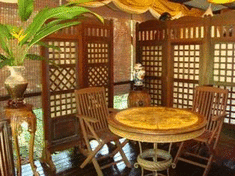























 SECURE & CONFIDENTIAL
SECURE & CONFIDENTIAL